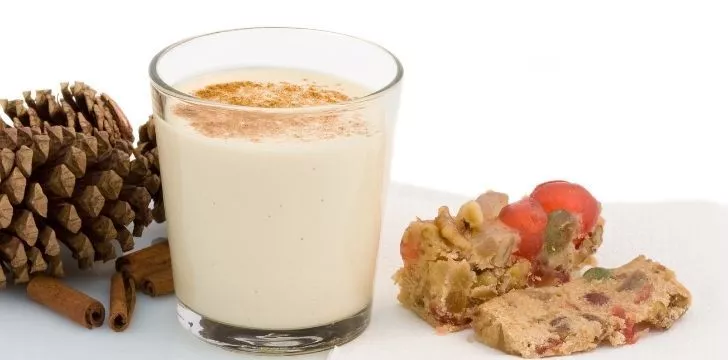Did you know that Americans consume an average of 135 million pounds of eggnog annually?
Eggnog is a popular winter beverage, especially during Christmas time.
It is a staple at Christmas parties and even has its own holiday!
In America alone, an average of 135 million pounds (61 million kg) of eggnog is consumed each year.
But do you know where this spiced creamy drink originated? And why do we love it so much?
Here are 5 fun facts about eggnog!
Eggnog was first created in medieval Europe.

The drink is believed to have originated from a European beverage called “posset.”
Posset was made by curdling hot milk with wine or ale and spices.
Eggnog was developed from posset among the British aristocracy.
The new drink consisted of eggs, milk, and sherry, which only the wealthy could afford.
Eggnog became a popular aperitif for toasting at parties, and thus, eggnog was born.
The word “eggnog” comes from “nog” or “noggin.”

The name eggnog has several possible roots.
Some say that in medieval East Anglia, England, there was an alcoholic beer brewed in that region called “nog.”
The word “nog” was first used in 1693 to describe an alcoholic drink, and it is suggested that eggnog came from this due to its alcohol content.
It is also believed that eggnog comes from the word “noggin,” a small wooden cup from which eggnog was drunk.
In Britain, the drink was known as “egg flip” because it was poured between jugs to mix it.
The word “eggnog” is thought to have originated in America around 1765.
Traditional eggnog was made with alcohol to kill bacteria.

Originally, eggnog was made with alcohol not for taste but for safety.
In medieval times, it was risky to drink milk straight, just as it can be risky today to drink unpasteurized milk.
So, alcohol was added to the milk to kill any harmful bacteria found in the dairy product.
Old recipes suggest that raw eggs were cured in alcohol, such as rum, for a few days to eliminate any bacteria from the eggs.
Most people let their eggnog sit for a few days to a week to ensure all bacteria were gone before consumption.
Today’s store-bought eggnog rarely contains alcohol due to FDA regulation, and there is no need to eliminate bacteria.
Store-bought eggnog also rarely contains raw eggs.
Eggnog caused a riot in the US.

In the winter of 1826, a riot broke out at the United States Military Academy in West Point, New York.
According to the story, a young cadet sneaked whiskey into the barracks and added it to the communal eggnog. As a result, the cadets became rowdy after drinking a few glasses of eggnog. A fight broke out, a lieutenant was knocked out, guns were fired, and windows were smashed. The incident led to 20 cadets being taken to court. The event is known as the Eggnog Riot, and it is believed that they had all drunk too much.
George Washington was a fan of eggnog and had his own recipe, which he often served to his guests. His eggnog contained several types of alcohol to enhance the flavor. Washington’s personal recipe included cream, milk, sugar, brandy, rye whiskey, Jamaica rum, and sherry. He instructed his cooks to mix the liquor first, separate the yolks and whites of eggs, add sugar to the beaten yolks, mix well, add milk and cream, slowly beat, beat the whites of eggs until stiff, and fold them into the mixture. The mixture was then left to set in a cool place for several days.
Eggnog was created as a way to enjoy a hot milk beverage without worrying about harmful bacteria and has become a beloved Christmas drink. The drink has evolved over time and is now available in non-dairy forms for vegans and those with allergies. To celebrate National Eggnog Day on December 24th, why not find a recipe and make your own?
FAQ
1. What is eggnog?
Eggnog is a traditional holiday beverage made with milk, cream, sugar, eggs, and sometimes alcohol. It has a rich, creamy texture and a sweet, spiced flavor that makes it a favorite during the winter months.
2. Where did eggnog originate?
The origins of eggnog are unclear, but it is believed to have originated in medieval Europe as a drink for the wealthy. It was often served at holiday feasts and was considered a symbol of wealth and prosperity.
3. What are some variations of eggnog?
There are many variations of eggnog, including versions made with different types of alcohol such as rum, brandy, or whiskey. Some people also add spices like nutmeg or cinnamon for an extra kick of flavor.
4. Is eggnog a healthy beverage?
While eggnog is delicious, it is not the healthiest beverage option. It is high in calories, fat, and sugar, so it should be enjoyed in moderation. Some people choose to make healthier versions of eggnog using almond milk or coconut milk instead of dairy milk.
5. What are some creative ways to use eggnog?
Eggnog can be used in a variety of creative ways, such as in baked goods like cookies or cakes. It can also be used as a creamy base for cocktails or as a topping for pancakes or waffles. Some people even use eggnog as a marinade for meat dishes.

Zayn Anderson is a prolific writer with a passion for uncovering the world’s intriguing facts. Armed with an insatiable curiosity, he delves into various subjects, from history and science to nature and technology.
